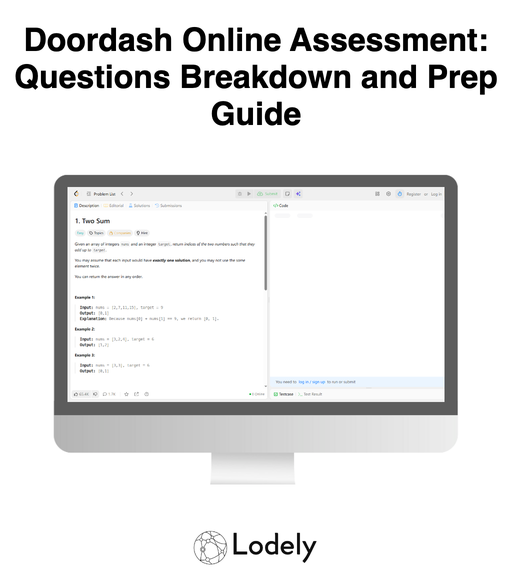Doordash Online Assessment: Questions Breakdown and Prep Guide
Thinking about “Cracking DoorDash’s Assessment” but not sure what’s coming? You’re not alone. Engineers see CodeSignal/HackerRank timers, logistics-flavored twists, and tricky edge cases — and the hardest part is knowing which patterns to sharpen.
If you want to walk into the DoorDash Online Assessment (OA) confident and composed, this guide is your playbook. No fluff. Real breakdowns. Strategic prep.
When to Expect the OA for Your Role
DoorDash varies OA timing and content by role and level. Expect differences across teams like Marketplace, Logistics/Dispatch, Consumer, and Merchant.
- New Grad & Intern — Most candidates receive an OA within 1–2 weeks of application or initial recruiter contact. Often the primary technical screen before a final loop.
- Software Engineer (Backend / Full-Stack / Platform) — Standard OA. Expect a CodeSignal or HackerRank link after recruiter outreach. Questions typically center on intervals, heaps, graphs, and sliding windows with a marketplace/logistics flavor.
- Mobile (iOS/Android) — DSA-heavy OA similar to backend, sometimes with a light focus on collection operations, string parsing, and concurrency or lifecycle edge cases in later rounds.
- Data Engineering / Analytics / ML — OA may include a DSA section plus SQL (joins, window functions) or simple ETL-style transforms. Occasionally a small Python data wrangling task.
- SRE / Infra / Security — Usually still an OA; may include parsing logs, rate limiting, or queue/backpressure mechanics.
- Senior Roles — Many still see an OA as the first filter. Sometimes replaced or supplemented by a live coding screen depending on the team.
Action step: When your recruiter emails you, ask for the platform, number of questions, timing, and whether it’s proctored. DoorDash often uses proctoring (webcam and screen monitoring).
Does Your Online Assessment Matter?
Short answer: yes — more than you might expect.
- It’s the main filter. Your OA score and code quality determine whether you advance to the onsite loop.
- It sets the tone. Interviewers may skim your OA submissions to tailor follow-ups.
- It mirrors real work. DoorDash’s marketplace/dispatch problems map to intervals, heaps, graph traversal, and throughput constraints.
- It signals engineering maturity. Clear naming, tests, complexity awareness, and careful edge-case handling matter.
Pro Tip: Treat the OA like a first interview. Write readable code, comment your approach succinctly, and handle edge cases (empty inputs, large N, ties, duplicates).
Compiled List of Doordash OA Question Types
You don’t need thousands of problems. You need the right patterns. Practice these:
- Car Pooling — Sweep Line / Difference Array
- Meeting Rooms II — Intervals / Min-Heap
- Merge Intervals — Sorting / Greedy
- Insert Interval — Intervals / Merge
- Network Delay Time — Graph / Dijkstra
- Shortest Path in Binary Matrix — Grid BFS
- K Closest Points to Origin — Heap / Quickselect
- Top K Frequent Words — Heap / Hash Map
- LRU Cache — Design / Hash Map + Doubly Linked List
- Task Scheduler — Greedy / Counting
- Subarray Sum Equals K — Prefix Sum / Hash Map
- Fruit Into Baskets — Sliding Window
- Hit Counter — Queue / Sliding Window
- Two City Scheduling — Greedy / Sorting
How to Prepare and Pass the Doordash Online Assessment
Think of your prep as a training cycle. Build speed, clarity, and reliability under time constraints.
1. Assess Your Starting Point (Week 1)
List your strong topics (arrays, hash maps, strings) and your weak ones (graphs, intervals, heaps). Take 1–2 timed CodeSignal practice tests or a HackerRank sample to baseline. Note where you lose time (parsing? off-by-one? heap APIs?).
2. Pick a Structured Learning Path (Weeks 2-6)
You have options:
- Self-study on LeetCode/HackerRank
- Great for disciplined learners. Create a DoorDash-focused problem set (intervals, heaps, graphs, sliding windows).
- Mock assessments / bootcamps
- Paid platforms simulate proctored CodeSignal/HackerRank environments with timers and partial scoring.
- Career coach or mentor
- A software engineer career coach can review code clarity, complexity trade-offs, and your pacing strategy.
3. Practice With Realistic Problems (Weeks 3-8)
Build a list of 40–60 problems covering intervals, heaps, BFS/DFS, Dijkstra, prefix sums, sliding windows, and simple design. Time-box each session. After solving, refactor for readability and test additional edge cases.
4. Learn Doordash-Specific Patterns
DoorDash’s domain shows up in disguise:
- Dispatch and batching — intervals, meeting-room style concurrency, sweep lines.
- ETAs and routing — Dijkstra/BFS, handling blockages and variable weights.
- Nearby search — k-closest points, heaps, quickselect, tie-breaking.
- Rate limits and throughput — sliding windows, queues, hit counters.
- Menu/catalog updates — set/map diffs, stable ordering, idempotency.
5. Simulate the OA Environment
Use CodeSignal or HackerRank practice modes with exact time limits (often ~90 minutes for 2–3 questions). Turn off distractions, keep a single editor, and practice reading prompts carefully before coding. If your OA is proctored, rehearse with a webcam on to normalize the setup.
6. Get Feedback and Iterate
Review your submissions 24 hours later. Track repeated mistakes (wrong data structure? forgetting tie-breaker? boundary checks?). Share solutions for feedback or compare against editorial approaches. Adjust your checklist before the next mock.
Doordash Interview Question Breakdown

Here are featured sample problems inspired by DoorDash’s OA style. Train these patterns, and you’ll cover most of the ground you need.
1. Batch Orders Into Couriers (Min Couriers Needed)
- Type: Intervals / Min-Heap
- Prompt: Given pickup and drop-off time windows for orders, determine the minimum number of couriers needed so that no courier handles overlapping deliveries.
- Trick: Sort by start time. Use a min-heap of end times to reuse couriers when possible. This is Meeting Rooms II with a logistics story.
- What It Tests: Interval reasoning, heap proficiency, and greedy reuse for capacity planning.
2. Compute Fastest Delivery ETA With Road Delays
- Type: Graph / Dijkstra
- Prompt: Given a directed graph of roads with weights (travel time) and a list of delayed edges (temporary weight increases), compute the shortest travel time from a restaurant to a customer.
- Trick: Build adjacency lists and run Dijkstra with a priority queue. Adjust edge weights for delays on the fly. Handle disconnected nodes and large graphs.
- What It Tests: Graph modeling, correctness under variant weights, and performance on large inputs.
3. Find K Closest Restaurants to a User
- Type: Heap / Geometry
- Prompt: Given restaurant coordinates and a user location, return the k closest restaurants. Break ties by name or id in lexicographic order.
- Trick: Use a max-heap of size k or quickselect. Compare squared distances to avoid float precision. Add tie-breaking in the comparator.
- What It Tests: Heap mastery, custom comparators, and careful tie handling.
4. Menu Diff: Added, Removed, and Updated Items
- Type: Hash Map / Set Operations
- Prompt: Given two lists of items (id, name, price, category) representing old and new menus, output items added, removed, and updated (where any field changes).
- Trick: Index by id. Compare fields to detect updates vs. adds/removes. Preserve deterministic output ordering (e.g., sort by id or name).
- What It Tests: Data modeling, efficient lookups, edge-case thoroughness, and clear output structuring.
5. User Rate Limiter (X Requests per T Seconds)
- Type: Queue / Sliding Window
- Prompt: Implement a per-user rate limiter allowing at most X requests in any sliding window of T seconds. Support record(userId, timestamp) and allow(userId, timestamp) operations.
- Trick: Maintain a deque per user, evict stale timestamps < t - T + 1, and check size < X. Watch memory growth and clean up inactive users.
- What It Tests: Throughput thinking, amortized time, and correctness under adversarial sequences.
What Comes After the Online Assessment

Clearing the OA opens the door to the full interview loop. From here, it shifts from “Can you code?” to “Can you build and collaborate at DoorDash scale?”
1. Recruiter Debrief & Scheduling
If you pass, expect a note within a few days. You’ll get high-level feedback and a breakdown of the next rounds. Ask about topics emphasized by the target team (dispatch, merchant tools, consumer growth) and prep suggestions.
2. Live Technical Interviews
You’ll pair with DoorDash engineers in a collaborative editor (CoderPad or similar). Expect:
- Algorithm & data structures similar to the OA, but interactive.
- Bug hunts or incremental refactors.
- Intentional communication: narrate trade-offs and verify edge cases aloud.
Pro tip: Revisit your OA code — interviewers may dig into your earlier approach.
3. System Design / Architecture Round
For mid-level and senior roles, you’ll design a service such as:
- Real-time ETA computation with traffic and batching
- Order assignment/dispatch service with SLAs
- Menu/catalog service with versioning and cache invalidation
They’re assessing:
- Decomposition, data modeling, and interfaces
- Scale, consistency, latency, and failure modes
- Pragmatic trade-offs and iteration strategy
4. Behavioral & Values Interviews
DoorDash values ownership, bias for action, and customer obsession. Expect prompts like:
- “Tell me about a time you shipped under tight constraints.”
- “Describe a decision you made with incomplete data.”
- “How did you handle a production incident and prevent recurrence?”
Use STAR (Situation, Task, Action, Result), quantify impact, and highlight cross-functional collaboration.
5. Final Round / Onsite Loop
A multi-interview block (virtual or onsite) may include:
- Another DSA round
- System design or API design
- Debugging or incident response scenario
- Cross-functional conversation with product/analytics
Pace yourself. Ask clarifying questions. Manage time across milestones.
6. Offer & Negotiation
If you pass, expect a verbal followed by a written offer. Compensation typically includes base salary, equity, and may include a sign-on bonus. Research market ranges and be ready with a data-driven negotiation.
Conclusion
You don’t need to guess; you need to target your prep. The DoorDash OA is demanding but predictable. If you:
- Identify weak areas early,
- Drill DoorDash-style patterns (intervals, heaps, graphs, sliding windows),
- Practice under realistic, proctored conditions,
- Write clean, tested, edge-case-aware code,
you’ll turn the OA into your competitive advantage — and walk into the next rounds with confidence.
For more practical insights and prep strategies, explore the Lodely Blog or start from Lodely’s homepage to find guides and career resources tailored to software engineers.






%2C%20Color%3DOriginal.png)



